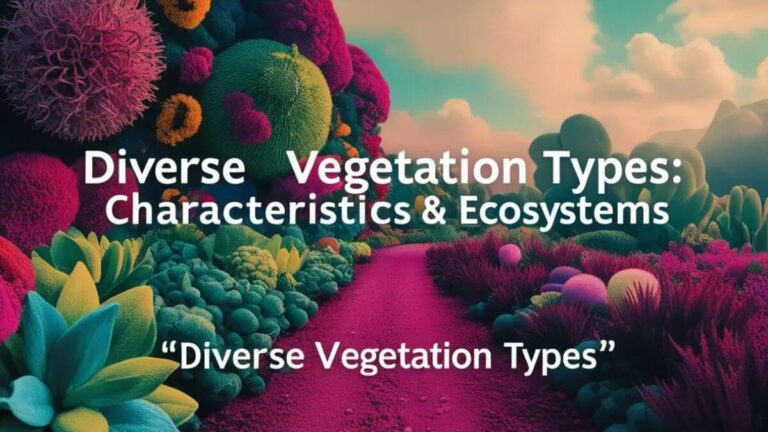Understanding the diverse vegetation types that populate our planet is essential for anyone interested in ecology, conservation, or simply enjoying the beauty of nature. Vegetation types play a critical role in ecosystems, influencing biodiversity, climate regulation, and soil health. In this comprehensive guide, we will delve into the various vegetation types, their characteristics, and their ecosystems, aiming to provide valuable insights for policymakers, environmental advocates, educators, and nature enthusiasts alike.
The Importance of Vegetation Types
Vegetation types refer to the various plant communities that exist in different environments around the world. They encompass a wide range of flora, from dense forests to arid deserts. Each type of vegetation is adapted to its unique environmental conditions, including climate, soil type, and geographical features.
How Many Vegetation Types Exist?
According to ecological classifications, there are primarily ten main vegetation types found globally:
- Tropical Rainforests
- Savannas
- Deserts
- Temperate Forests
- Grasslands
- Tundra
- Mediterranean Forests
- Boreal Forests (Taiga)
- Wetlands
- Alpine Vegetation
Each of these vegetation types is crucial for maintaining ecological balance and supporting various life forms. Let’s explore each type in detail.
1. Tropical Rainforests
Characteristics
Tropical rainforests are characterized by high rainfall, warm temperatures, and incredible biodiversity. These forests are dense with trees, often exceeding 100 feet in height, and feature multiple layers of vegetation, including the emergent layer, canopy, understory, and forest floor.
Ecosystem Role
These ecosystems are vital for carbon storage, oxygen production, and habitat for countless species. They also play a significant role in regulating the global climate by absorbing large amounts of carbon dioxide.
2. Savannas
Characteristics
Savannas are grassland ecosystems characterized by scattered trees and shrubs. They typically experience a distinct wet and dry season, which influences the vegetation growth patterns.
Ecosystem Role
Savannas support large herbivores, such as elephants and giraffes, and serve as essential grazing grounds for wildlife. They also help maintain soil fertility and prevent desertification.
3. Deserts
Characteristics
Deserts are defined by their low precipitation levels and extreme temperature variations. Vegetation in deserts is sparse, featuring drought-resistant plants such as cacti, succulents, and xerophytes.
Ecosystem Role
Despite their harsh conditions, deserts are home to uniquely adapted species and play a crucial role in maintaining the Earth’s hydrological cycle.
4. Temperate Forests
Characteristics
Temperate forests are characterized by four distinct seasons and a diverse range of deciduous and coniferous trees. Common trees include oak, maple, and pine, which shed their leaves in winter.
Ecosystem Role
These forests are important for biodiversity, providing habitat for various species. They also play a role in water purification and soil stabilization.
5. Grasslands
Characteristics
Grasslands, or prairies, showcase grasses thriving in abundance, while trees and shrubs take a backseat. They often experience periodic wildfires that maintain the ecosystem’s health.
Ecosystem Role
Grasslands are essential for agriculture and grazing, providing food for livestock and supporting a range of wildlife.
6. Tundra
Characteristics
The tundra is characterized by its cold temperatures, short growing seasons, and permafrost. Vegetation is limited to hardy species like mosses, lichens, and low shrubs.
Ecosystem Role
Tundras are crucial for carbon storage and serve as breeding grounds for migratory birds and other wildlife.
7. Mediterranean Forests
Characteristics
Mediterranean forests experience hot, dry summers and mild, wet winters. They often feature evergreen trees like oak and pine, along with a variety of shrubs.
Ecosystem Role
These forests are rich in biodiversity and are vital for soil conservation and water regulation.
8. Boreal Forests (Taiga)
Characteristics
Boreal forests, or taiga, feature coniferous trees such as spruce, fir, and pine. They experience long, cold winters and short summers.
Ecosystem Role
Boreal forests are significant for carbon sequestration and provide habitat for diverse wildlife, including moose and wolves.
9. Wetlands
Characteristics
Wetlands are areas where water covers the soil, either permanently or seasonally. They can be freshwater or saltwater and feature a variety of plants, including reeds, cattails, and water lilies.
Ecosystem Role
Wetlands play a crucial role in flood control, water filtration, and providing habitat for fish and other wildlife.
10. Alpine Vegetation
Characteristics
Alpine vegetation thrives in high-altitude areas, where it endures short growing seasons and harsh conditions. Plants are typically low growing, such as grasses, mosses, and alpine flowers.
Ecosystem Role
Alpine ecosystems are important for water supply and biodiversity, providing habitat for unique species adapted to extreme conditions.
Conclusion
Understanding both the diverse vegetation types and their characteristics is essential for effective environmental management and conservation efforts. Each vegetation type plays a unique role in its ecosystem, contributing to the overall health of our planet.
So, as you explore these diverse vegetation types, consider how you can contribute to their conservation. Whether you are a policymaker, educator, or simply a nature enthusiast, your efforts can help protect these vital ecosystems for future generations.
Call to Action
Furthermore, engage with your community to promote awareness of vegetation types and their importance. Participate in local conservation initiatives, support sustainable practices, and encourage others to appreciate the beauty and diversity of our planet’s vegetation. Moreover, together, we can make a difference in preserving the rich tapestry of life that exists on Earth.
FAQ’s
What are the main diverse vegetation types found around the world?
There are several main diverse vegetation types, including tropical rainforests, savannas, deserts, temperate forests, and grasslands. Each type has unique characteristics that contribute to global biodiversity.
How do diverse vegetation types of impact local ecosystems?
Diverse vegetation types significantly impact local ecosystems by providing habitat for various species, regulating climate, and maintaining soil health. Additionally, they contribute to the overall balance of the ecosystem.
What are the characteristics of tropical rainforests among the diverse vegetation types?
Tropical rainforests, one of the most vibrant and diverse vegetation types, thrive with high rainfall, showcase rich biodiversity, and feature multilayered canopies. These features support numerous species and play a crucial role in carbon storage.
Why are savannas considered important among the diverse vegetation types?
Savannas are important among the diverse vegetation types because they provide grazing grounds for large herbivores and maintain soil fertility. Moreover, their seasonal changes help regulate the local climate.
How can understanding diverse vegetation types of aid in conservation efforts?
Understanding diverse vegetation types helps inform conservation efforts by highlighting the unique roles each type plays in ecosystems. Consequently, this knowledge allows policymakers and environmental advocates to implement effective protection strategies.









10 Comments
Diverse vegetation types play a crucial role in maintaining ecological balance. From lush forests and grasslands to deserts and wetlands, each ecosystem supports unique plant species adapted to their environment. These varied habitats not only provide food and shelter for wildlife but also contribute to climate regulation and overall biodiversity, ensuring a sustainable planet.
The blog post explore the various vegetation types, their characteristics, and their ecosystems, aiming to provide valuable insights for policymakers, environmental advocates, educators, and nature enthusiasts alike.
Diverse vegetation types contribute to unique ecosystems, offering habitats, supporting biodiversity, and playing a crucial role in environmental balance.
Diverse vegetation types contribute to unique ecosystems, offering habitats, supporting biodiversity, and playing a crucial role in environmental balance.
Explore the beauty and significance of diverse vegetation types, from lush forests to vibrant grasslands, for a healthier planet.
Thanks for this insightful post! 🌿✨ I loved learning about the unique traits of different vegetation types and how they shape our ecosystems. 🌍💚
Exploring diverse vegetation types reveals the rich complexity of ecosystems and their vital role in sustaining life on Earth.
The diversity of vegetation types showcases the beauty and adaptability of nature! A fascinating topic for anyone interested in ecosystems and biodiversity.
Explore the beauty of nature with this insightful post on diverse vegetation types! It’s amazing how ecosystems thrive through unique characteristics. A must-read for nature enthusiasts and curious minds!
Pingback: Deciduous vs Coniferous Forests: Key Differences & Benefits